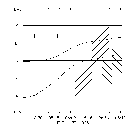What holds an arcade up?
Science Nugget: Feb 05, 1999
Flares often result in arcades of bright loops, seen in X-ray and then
later on in chromospheric lines as post-flare loops. Below the loops, there
is a void. Why is this? In this "science nugget" we show an example of
this in the context of the long search for pre-flare heating, a topic of
theoretical and observational significance, especially via soft X-ray images
such as those of Yohkoh SXT.
Preflare brightening in a typical arcade flare
In the following we discuss some of the properties of the pre-flare phase
of an over-the-limb arcade flare of December 23, 1998. Here are some images
from the earliest stages of the brightening:

These show an arcade seen end-on at the NE limb, in the process of formation.
The plots below show the GOES event, with the timing of the images shown
above, plus photometry from SXT - clearly the slow rise leading up to the
event should be called a "precursor", since the SXT data show that things
appear to be brightening in place.
Why is this interesting?
Yohkoh has seen many arcade events such as this one. They share
(by definition) the property of an apparently empty tunnel, seen end-on
as a void below the loops (see S. Tsuneta's description of the celebrated
"candle flame" flare of Feb. 21, 1992 . Chromospheric lines such as
H-alpha notoriously produce "coronal rain" at the surface of this tunnel,
in discrete loops, as the hot, dense X-ray loops go thermally unstable.
But why don't the loops simply crash, and why do they form around a roughly
cylindrical void? We speculate that this is because of magnetic pressure
internal to the cavity. The cylindrical configuration points to the existence
of a separate domain in the form of a flux rope. We know that such large-scale
flux ropes also must exist in quiescent
filament channels, which indeed can erupt to form large, weak arcades
in quiet-Sun areas away from active regions. One answer to the question
"why is this interesting?" would be - what is the behavior of the current
sheet that must form to separate the arcade loop domain from the tunnel
interior domain?
What about precursors to flares?
This subject is fraught with confusion. Many flares show precursors of
the type seen above, i.e. a slow rise prior to the impulsive phase. Many
other flares don't. Is gradual excitation of a magnetic loop about to flare
one of the prerequisites for its flaring? Farnik and Savy, in a recent
paper (Solar Phys. 183, 339, 1998) provide the best answer yet, based on
the use of SXT images to locate the GOES precursor as we did above. They
found 8 out of 32 cases in which a pre-flare loop arguably could be seen
prior to the flare itself. In the example above we have an exceptionally
clear case of this. One can trace an apparently continuous development
of flare brightening, following the precursor seen above, into the flare
state itself. So it appears that loops brighten slowly and in place,
without sudden distortions resulting from "restructuring". But theorists
beware - the Farnik-Savy result also strongly implies that pre-flare heating
is by no means obligatory!
As frequently happens, the ideas presented in a "science nugget" such
as this could be completely wrong, since we're trying to describe what
we are seeing long before accurate theories can be developed. So, if you
see something controversial or misleading, please contact the author quickly!
February 5, 1999: Hugh Hudson (email hudson@isass0.solar.isas.ac.jp)



